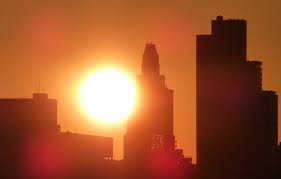*The sun affects our lives in more ways than we can imagine (even though it is about 150 million km away!): produces heat, light, energy for photosynthesis, food, wind, ocean currents, tides, radiation, weather, etc.
After today’s lecture, you should be able to:
-Explain the structure of the sun and its energy source.
-Describe the effects of sunspots, solar wind, and magnetic storms on Earth and explain the role of Earth’s magnetic field.
The Sun’s Size:
- Diameter = 1,400,000km (868,000miles)
- Diameter of Earth = 12,750km (7,920mi)
- More than 1 million Earth’s would fit inside the sun!
The Sun’s Energy:
- The sun is a star, and all stars get their energy from fusion: combining the nuclei of lighter elements to form a heavier element
- During fusion, matter is converted into energy! (E=mc2)
- Fusion can only take place under intense pressure and heat– so intense that the parts of an atom are torn apart (high heat) and the nuclei from different atoms are fused together (high pressure)!
- When the nuclei fuse, some of the mass is lost as energy!
- The sun’s energy is a result of the fusion of 4 H nuclei to form 1 He nucleus.
The Sun’s Layers: (From inside to outside):
- Core: -Consists mostly of H and He
ions in a plasma state (A 4th state of matter made-up only of charged particles.)
-Where fusion occurs
-100X’s denser than water
-15,600,000 °C
- Radiative Zone:
-Plasma layer surrounding the core.
-8,000,000 → 2,000,000 °C
- Convection Zone:
-Plasma layer surrounding the radiative zone.
-Rising and falling currents of plasma carry energy to the sun’s surface, where it is radiated out into space as sunlight.
-1,500,000 °C
- Photosphere:
-The visible surface of the sun.
-6,000 °C
- Chromosphere:
-The inner or first layer of the sun’s atmosphere.
-Extends thousands of miles above the photosphere.
-20,000 °C temperature causes the H w/in it to emit a reddish color.
–Solar Prominences are found here: Clouds of charged particles/ plasma that erupt off the surface of the sun.
- Corona:
-The thin, outer layer of the sun’s atmosphere.
-Can escape and become solar wind.
-1,000,000 → 3,000,000 °C
- Chromosphere:
-The inner or first layer of the sun’s atmosphere.
-Extends thousands of miles above the photosphere.
-20,000 °C temperature causes the H w/in it to emit a reddish color.
–Solar Prominences are found here: Clouds of charged particles/ plasma that erupt off the surface of the sun.
- Corona:
-The thin, outer layer of the sun’s atmosphere.
-Can escape and become solar wind.
-1,000,000 → 3,000,000 °C
Features on the Sun:
- Sunspots: magnetic ‘storms’ that appear as dark spots on the photosphere
-Lower temps. than the surrounding photosphere, thus they appear darker
-Move from left to right across the surface of the sun as viewed from Earth, thus indicating that the sun rotates!
-Sunspot activity tends to increase or peak every 11 years. This is known as the sunspot cycle.
- Solar Wind: A constant stream of electrically charged particles given off by the corona and solar flares.
-Made-up mainly of protons and electrons, and travel toward Earth at 450 km/s, reaching Earth in a few days!
-Deflected by Earth’s magnetic field, which shields us from these electrically charged particles wh/are harmful to life!
-When these particles interact w/Earth’s magnetic field in the upper atmosphere, auroras are formed.
- Magnetic Storms: Occur on Earth when large solar flares release huge amounts of charged particles.
-Can disrupt cell phone service, damage unprotected electrical appliances, and cause auroras to be visible in mid-lats.
